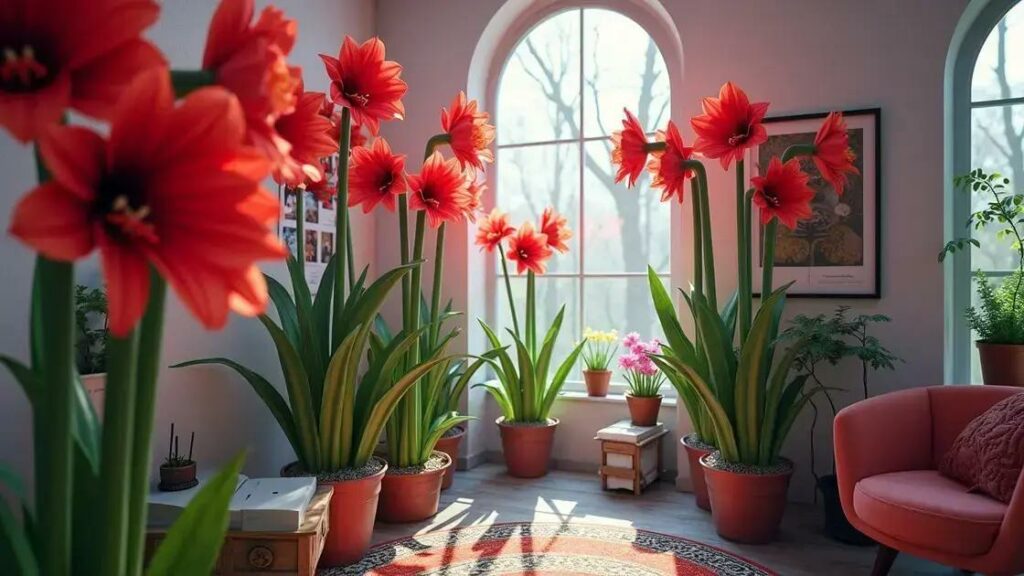How to care for amaryllis plants indoors can feel daunting, especially if you’re new to indoor gardening. However, the colorful blooms they produce can bring joy to any space. Whether you’re eager to watch them bloom or just want to keep them lush and green, understanding their needs is essential. Let’s explore how to create the perfect environment for these stunning plants.
Table of Contents
ToggleLight requirements for thriving amaryllis
Light requirements for thriving amaryllis are crucial for ensuring these stunning indoor plants bloom beautifully. Amaryllis thrive best in bright, indirect sunlight, allowing their lush green leaves and striking flowers to flourish.
To optimize the light conditions for your amaryllis, consider the following tips:
- **Choose the right location:** Place your amaryllis near a window that receives filtered light. Avoid harsh direct sunlight, which can scorch the leaves.
- **Rotate the pot regularly:** This helps the plant receive even light exposure on all sides, promoting balanced growth.
- **Monitor light intensity:** During the shorter days of winter, you may need to move your amaryllis closer to the light source to ensure it gets enough brightness.
Here’s a quick guide to light intensity needs:
| Light Condition | Best Location | Duration |
|---|---|---|
| Bright, indirect light | Southern or eastern windows | 6-8 hours |
| Low light | North-facing windows | 4-6 hours |
| Direct light | Not recommended | Less than 2 hours |
During the initial growth period, provide ample light to ensure your amaryllis develops strong stems and healthy leaves. Amaryllis can also benefit from exploring indoor gardening techniques in varying light conditions.
Keep an eye on your amaryllis for signs of inadequate light. If you notice leggy growth or pale foliage, it might be time to adjust their lighting situation.
In summary, ensuring your amaryllis receives the correct light is essential for vibrant blooms. By choosing the right spot and adjusting for seasonal changes, you’ll keep your plants thriving.
Watering amaryllis plants: the right approach

Watering amaryllis plants: the right approach is essential for their success. Getting the watering routine right ensures your amaryllis thrives and blooms beautifully.
Amaryllis prefer well-draining soil and should be watered carefully to avoid overwatering, which can cause bulb rot. Here’s how to do it properly:
- **Check the soil moisture:** Before watering, stick your finger about an inch into the soil. If it feels dry, it’s time to water.
- **Water thoroughly:** When you do water, ensure that it seeps through the drainage holes of the pot. This ensures the roots receive adequate moisture.
- **Adjust frequency seasonally:** During the active growing season, typically from spring to summer, water more often (about once a week). In the dormant winter months, reduce watering.
Here’s a quick reference table for your amaryllis watering needs:
| Season | Watering Frequency | Soil Condition |
|---|---|---|
| Spring/Summer | Once a week | Dry to touch |
| Fall/Winter | Once every 2-3 weeks | Dry, avoid soggy |
If you notice yellowing leaves, it may indicate overwatering, while wilting can signal underwatering. For best practices in care, consider exploring indoor gardening techniques.
Remember, the key to watering amaryllis successfully lies in the balance of moisture. By keeping a close watch on the soil’s condition and adjusting your watering routine accordingly, your amaryllis will reward you with spectacular blooms.
Fertilizing amaryllis for vibrant blooms
Fertilizing amaryllis for vibrant blooms is key to achieving stunning flowers. Proper fertilization nourishes your plants, promoting robust growth and colorful displays.
When it comes to fertilizing your amaryllis, timing and choice of fertilizer are important:
- **Choose the right fertilizer:** A balanced fertilizer with equal parts nitrogen, phosphorus, and potassium is ideal. Look for numbers like 10-10-10 or 20-20-20 on the label.
- **Determine the fertilization schedule:** Start fertilizing when leaves emerge in the spring and continue every 4-6 weeks until blooming ends. Cease fertilization as the plant enters dormancy.
- **Use liquid versus granular:** Liquid fertilizers can be more readily absorbed, while granular options should be mixed into the soil, releasing nutrients slowly.
Here’s a helpful guide on the fertilization process:
- **Dilute the fertilizer:** For liquid fertilizers, mix the recommended amount with water.
- **Apply to moist soil:** Water the amaryllis before fertilizing to prevent root burn.
- **Monitor growth:** Check for signs of growth after fertilization. Healthy new leaves and flower buds indicate successful feeding.
In addition to standard fertilizers, consider the benefits of using organic options. Compost or well-aged manure not only nourishes but improves soil structure.
For further insights into enhancing your indoor gardening skills, consider exploring indoor gardening techniques that include fertilization strategies.
By establishing a consistent fertilization routine, your amaryllis will reward you with vibrant blooms that brighten up your home throughout the growing season.
In conclusion
Caring for amaryllis plants indoors is a rewarding experience that can bring joy and color to your home. By following the guidelines on light requirements, watering approaches, and fertilizing techniques, you can ensure your amaryllis flourishes. Remember that these plants thrive under proper care, making it essential to monitor their needs throughout the growing season. For more insights and tips on enhancing your indoor garden, explore various resources that can further support your gardening journey.

